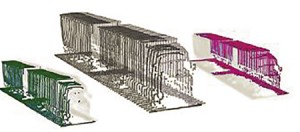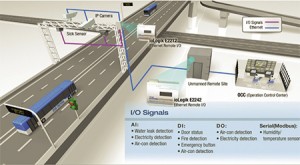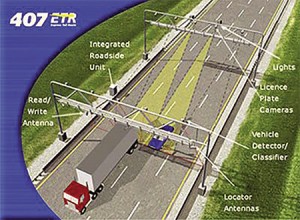 Vehicle to Roadside Communication: Transponders have become the most common form of vehicle identification. In this technology, a radio-frequency identification (RFID) chip is embedded in a unit or sticker, called an electronic tag, which is mounted on the windshield near the rearview mirror of the vehicle. As the tag passes under a gantry with a mounted transmitter, it responds to radio signals. Laser and infrared signals have also been tested but the radio frequency spectrum provides the greatest level of accuracy.
Vehicle to Roadside Communication: Transponders have become the most common form of vehicle identification. In this technology, a radio-frequency identification (RFID) chip is embedded in a unit or sticker, called an electronic tag, which is mounted on the windshield near the rearview mirror of the vehicle. As the tag passes under a gantry with a mounted transmitter, it responds to radio signals. Laser and infrared signals have also been tested but the radio frequency spectrum provides the greatest level of accuracy.
Electronic tags can be classified according to the degree to which they can be programmed.
- Type I: The chip does not have any processing capabilities and the information on it is fixed (read only)— usually just a hard-wired identification number.
- Type II: These chips have an updateable area which can be used to encode information such as time and point of entry.
- Type III: These tags contain a microprocessor. They can be used to communicate such information as account balance and driver and vehicle information to roadside or overhead sensors. Type III tags are also called “smart” tags.
Tags can also be classified by power source:
- Passive: Passive RFID tags have no internal power supply. Incoming radio frequency signals are detected by the antennae, which power up the tag and transmit a response. Having no on board power supply means that the tag can be very small, although the amount of data stored in them is also very small.
- Semi-Passive (or Semi-Active): these tags are similar to passive tags but have a battery which allows the tag to be constantly powered. Semi-passive tags respond faster and have a stronger reading than passive tags.
- Active: These tags may be connected to the vehicle power source. They are able to store more information and also receive and store additional information sent by roadside communications units. They also have a much greater range.
Interoperability
 A major concern regarding electronic tags is the degree to which they are interoperable with tags from other regions. If there is to be an area-wide tolling program, a single tag must work in all jurisdictions. This is not the case with most systems in the US
A major concern regarding electronic tags is the degree to which they are interoperable with tags from other regions. If there is to be an area-wide tolling program, a single tag must work in all jurisdictions. This is not the case with most systems in the US
ETC is paving the way for deployment of Intelligent Transportation Systems. ETC technologies, namely in-road systems, video systems, and electronic tags, are competing among themselves for the expected growth in ITS.
Future uses for the electronic tag may also include the universal tag, which can be used for multiple purposes (e.g. on subways and other public transit systems, as well as for purchases in stores and restaurants). Although the universal tag is not widespread in the US, there is in use the multi-use payment system that makes transit payment more convenient. Payment for bus, rail, and other public or private sector goods and services can be made using transit fare cards at terminal gates or at check-out counters and phone booths of participating merchants located near transit stations. Multi-use systems may also incorporate the ability to pay highway tolls with the same card.
Future Trends
The next stage of tolling deployment is likely to be a mileage-based system, i.e., the driver pays periodically for miles driven in a region. While odometer, phone and GPS systems all have the potential for mileage tolling. RFID tags with dedicated short range communications (DSRC) are also capable of similar functions, they are already in use and will be the dominant technology for some time. They will, however, require significant roadside infrastructure to accomplish area-wide tolling.
 The Toronto 407ETR is one of the most sophisticated toll roads in the world in terms of ETC. Tolling is entirely electronic, and there are no manual tolling lanes or booths. Tolls are based on the number of kilometres travelled. The 407ETR ETC technology combines transponders with video enforcement. The tag readers poll the vehicle as it approaches the gantry to triangulate vehicle trajectory, get the best read, and minimize errors.
The Toronto 407ETR is one of the most sophisticated toll roads in the world in terms of ETC. Tolling is entirely electronic, and there are no manual tolling lanes or booths. Tolls are based on the number of kilometres travelled. The 407ETR ETC technology combines transponders with video enforcement. The tag readers poll the vehicle as it approaches the gantry to triangulate vehicle trajectory, get the best read, and minimize errors.
There are two types of transponders in use in the system: one for regular vehicles and the other for vehicles with a gross weight over five tons. Transponders are the property of the 407ETR and are leased. Using a transponder saves the customer on the video toll charge per trip. All vehicles using the 407ETR are required to be registered with the 407ETR authorities. If a person is not registered and drives on the 407ETR, the license plate number is taken and sent to the Ministry of Transportation in order to get vehicle information and classification for billing purposes. Scofflaws may have their vehicle registration revoked. If a vehicle is not registered, public sources are used to find addresses.
 TrafficInfraTech Magazine Linking People Places & Progress
TrafficInfraTech Magazine Linking People Places & Progress


